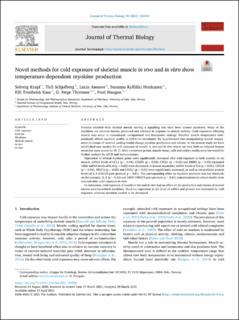| dc.description.abstract | Proteins secreted from skeletal muscle serving a signalling role have been termed myokines. Many of the myokines are exercise factors, produced and released in response to muscle activity. Cold exposures affecting muscle may occur in recreational, occupational and therapeutic settings. Whether muscle temperature independently affects myokine profile, is still to be elucidated. We hypothesized that manipulating muscle temperature by means of external cooling would change myokine production and release. In the present study we have established new models for cold exposure of muscle in vivo and in vitro where rat hind limb or cultured human myotubes were cooled to 18 °C. After a recovery period, muscle tissue, cells and culture media were harvested for further analysis by qPCR and immunoassays. Expression of several myokine genes were significantly increased after cold exposure in both models: in rat muscle, mRNA levels of CCL2 (p = 0.04), VEGFA (p = 0.02), CXCL1 (p = 0.02) and RBM3 (p = 0.02) increased while mRNA levels of IL-6 (p = 0.03) were decreased; in human myotubes, mRNA levels of IL6 (p = 0.01), CXCL8 (p = 0.04), VEGFA (p = 0.03) and CXCL1 (p < 0.01) were significantly increased, as well as intracellular protein levels of IL-8 (CXCL8 gene product; p < 0.01). The corresponding effect on myokine secretion was not observed, on the contrary, IL-8 (p = 0.02) and VEGF (VEGFA gene product) p < 0.01) concentrations in culture media were reduced after cold exposure in vitro. In conclusion, cold exposure of muscle in vivo and in vitro had an effect on the production and release of several known exercise-related myokines. Myokine expression at the level of mRNA and protein was increased by cold exposure, whereas secretion tended to be decreased. | |
